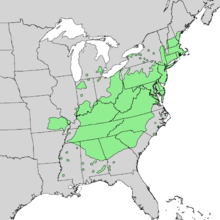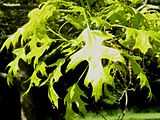Quercus coccinea
| Scarlet oak | |
|---|---|
 | |
| Tree in autumn | |
| Scientific classification | |
| Kingdom: | Plantae |
| (unranked): | Angiosperms |
| (unranked): | Eudicots |
| (unranked): | Rosids |
| Order: | Fagales |
| Family: | Fagaceae |
| Genus: | Quercus |
| Section: | Lobatae |
| Species: | Q. coccinea |
| Binomial name | |
| Quercus coccinea Muenchh. | |
 | |
Quercus coccinea, the scarlet oak, is an oak in the red oak section Quercus sect. Lobatae. The scarlet oak can be mistaken for the pin oak, the black oak, or occasionally the red oak. On scarlet oak the sinuses between lobes are "C"-shaped in comparison to pin oak (Q. palustris), which has "U"-shaped sinuses and the acorns are half covered by a deep cap.[1]
Scarlet oak is mainly native to the eastern United States, from southern Maine west to eastern Oklahoma, and south to southern Alabama. It is also native in the extreme south of Ontario, Canada. It occurs on dry, sandy, usually acidic soils. It is often an important canopy species in an oak-heath forest.[2][3]
Description

Q. coccinea is a medium-large deciduous tree growing to 20–30 m tall with an open, rounded crown. The leaves are glossy green, 7–17 cm long and 8–13 cm broad, lobed, with seven lobes, and deep sinuses between the lobes. Each lobe has 3-7 bristle-tipped teeth. The leaf is hairless (unlike the related pin oak, which has tufts of pale orange-brown down where the lobe veins join the central vein). The common English name is derived from the autumn coloration of the foliage, which generally becomes bright scarlet; in contrast, pin oak foliage generally turns bronze in autumn. The acorns are ovoid, 7–13 mm broad and 17–31 mm long, a third to a half covered in a deep cup, green maturing pale brown about 18 months after pollination; the kernel is very bitter.
Uses
Scarlet oak is often planted as an ornamental tree, popular for its bright red fall color. The cultivar 'Splendens' has gained the Royal Horticultural Society's Award of Garden Merit.[4]
The wood is generally marketed as red oak, but is of inferior quality, being somewhat weaker and not forming as large a tree.
References
- ↑ University of Connecticut Plant Database: Quercus coccinea
- ↑ The Natural Communities of Virginia Classification of Ecological Community Groups (Version 2.3), Virginia Department of Conservation and Recreation, 2010
- ↑ Schafale, M. P. and A. S. Weakley. 1990. Classification of the natural communities of North Carolina: third approximation. North Carolina Natural Heritage Program, North Carolina Division of Parks and Recreation.
- ↑ http://apps.rhs.org.uk/plantselector/plant?plantid=5447
External links
| Wikimedia Commons has media related to Quercus coccinea. |